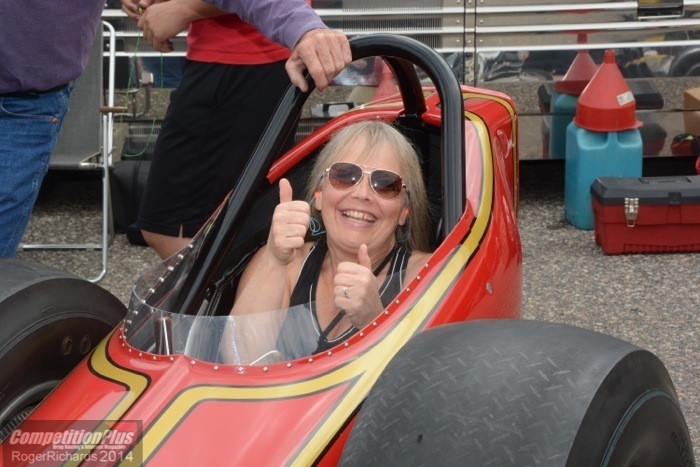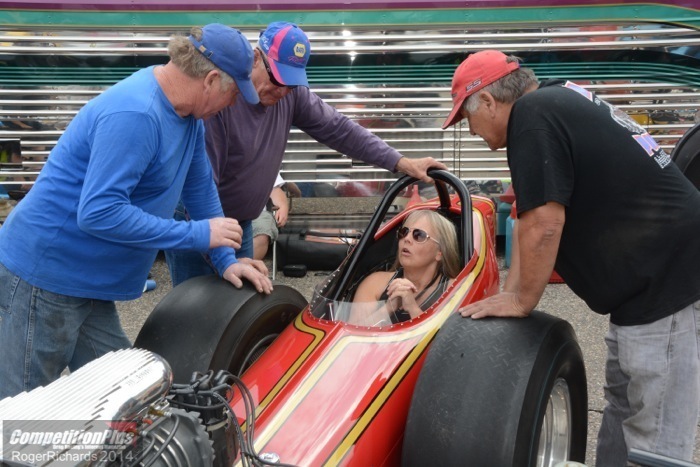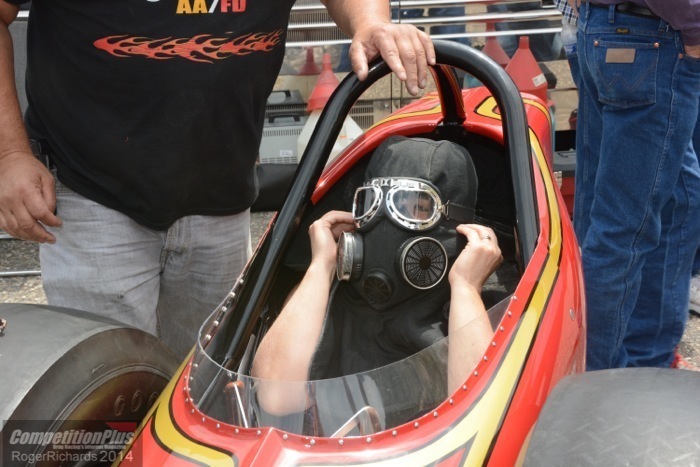DENVER CACKLEFEST A LABOR OF LOVE
It sat there for years in somebody’s back yard in Mead, Colo., ignored, misunderstood, and subjected to the elements.
But Kenny Schell found the old dragster and “adopted” it. Then he wasn’t sure exactly what he had on his hands that cost him $1,500.

But Kenny Schell found the old dragster and “adopted” it. Then he wasn’t sure exactly what he had on his hands that cost him $1,500.
So he phoned photographer Pete Garramone, who has chronicled Colorado’s drag-racing history as far back as the 1950s. Schell asked Garramone if he might have any clues about the history of this machine. And that phone call was the first step in Schell’s restoration process that brought the Spickler Automotive Dragster back to life and eventually to the recent Mopar Mile High Nationals at Bandimere Speedway, near Denver.
The sleek, red, feather-light, slingshot beauty was one of six cars on hand at the region’s premier dragstrip for its first cacklefest during an NHRA national event.
Mike Harvey, who owns the recreation of Roger Guzman's "Assassination" 1971 Vega, spearheaded the effort to get the NHRA's blessing to include the vintage vehicles in its 35th annual visit to Thunder Mountain. Among the cars were Steve Panalis' "Outcast" altered and a Rice & Williams entry.
And each had a story – about how Junior Kaiser, regarded as Colorado's most well-known drag racer, drove wheels off of it . . . or how they were ill-handling beasts . . . or how much fun these racers had with the cars, despite not having as much funding as their California counterparts back in the day.
The storyteller of the bunch was George ("A1 George") Huitron, who called himself "one of the last stick racers" on the street scene in the 1960s. He works on the Outcast car and another of Kaiser's babies that won the 1980 and 1982 Division 5 championships.
He beamed with pride when educating media members and curious observers about the cars as he offered them precious seat time in the Spickler dragster or the Outcast. "You know, people have offered us $100 for the chance to do what you’re doing," he said just before yanking a gas mask over the head of a lucky pretender. And his eyes grew as big as brake rotors when he explained the difference between the sound of the approximately 5,000-horsepower engine running on alcohol ("Popopopopopop") and the sound of it with nitromethane ("POPOPOPOPOPOPOP").
Huitron was fussing over gas masks, goggles, boxes to stand on (to make it easier to slip into the cockpits), and last-minute instructions for the seat-fillers. ("Now, when you get in the car, don’t touch anything! If you see somebody making a gesture to do something, ignore us! We're nobodies! Just don’t touch anything!!" he emphasized). Steve Panalis, the picture of confidence, interjected warnings about the noise and the body-in-a-paint-mixer shake that was about to happen – as happy to help as he was amused to see if he could put the fear of The Almighty into the drag-racing tenderfoots.
Meanwhile, Kenny Schell was standing in the background, smiling and clearly enjoying just being there at Bandimere Speedway, at the center of the drag races, just where he always had wanted to be since he was a teenager. "When I was young, I went to the drags," he said, "and I always wanted to own one of these cars."

One of the first things he discovered, with guidance from Garramone and the Internet, was who produced the car. The giveaway was the short torsion bars on the front axle. The almost-microscopic tech number on the roll bar showed that Mark Williams Enterprises inspected the car back in the day.
Revelations about the car came in bits and pieces, but Schell finally was able during the SEMA Show to meet original owner Ernie Spickler, who had owned a speed shop and parts house in Denver in the 1960s but lives in Las Vegas today. Spickler said he had the original bill of sale for the frame and that his stepbrother back in Colorado, Doug Jordan, had the running gear in his possession. This car, as it turned out, was the first dragster west of the Mississippi River to be equipped with a reverser.
Jim Armistead built the motor, a 392 Hemi that came out of a '57 Chrysler production car.
While Schell is content to stay on the sidelines with his car, Panalis loves to stay active on the track with the Junior Kaiser-popularized "Outcast" altered. The NHRA banned the class in 1975 (because of these cars' wickedly unpredictable nature – "They never make the same run twice," he said). But that just means he has to find match-race deals to be able to take to the quarter-mile. He does that about six times a year.
He drove this sometimes-ill-handling brute – which he has owned for 40 years – until he was injured in an oil-field accident years ago and put local legends Johnny Abbott and Keith Jackson in the seat. The Outcast runs a custom Keith Black motor with Brad Anderson heads.
Ron Avers methodically did some touch-up painting on Harvey's Assassination Nitro Funny Car as the Denver sun beat down on him last weekend. Harvey built the chassis three years ago for this classic, and it strutted its stuff at cackle shows without the body on it for a long time. But it sported the new body at its previous public appearance, the Fourth of July show.
Harvey persevered in bringing this exhibition to Bandimere Speedway, making seemingly countless phone calls to the NHRA and to his fellow nostalgia-car owners. And finally, as they all lined up there, he had a chance to enjoy the result of his efforts. And he reminisced about not only the cars and the competition past but also about Bandimere Speedway and its owners.
"John Bandimere Sr. used to make it his job during the national event," Harvey said, gazing up at the steep and brushy Thunder Mountain, "to stop people from parking up on top and coming down the mountain and sneaking into the races. He wouldn't yell at them when they were on top of the mountain. He'd wait until they got all the way down to the bottom. Then he'd tell them that he could get the sheriff and have them arrested or they could climb back up the mountain and go back to their cars."
Piped up one of Harvey's friends, "There's rattlesnakes all over that mountain up there."
The sight of those gate-crashers scurrying back up through the scrub-brush had to have been something, but nothing as satisfying as what Kenny Schell saw. He saw family. He saw camaraderie. He saw the beautiful cars that brought them all together. "These people are all so close-knit. It’s neat," he said.
And another ear-piercing d-d-d-d-d-d-d-d-d-d-d punctured the thin air. George Huitron was in his glory. Steve Panalis could feel the rhythm and knew what the next beat would be. The crowd was watching and snapping pictures. And Kenny Schell was standing back, watching it all, and smiling.
The act of cutting and pasting articles from this publication to a message board is a clear copyright violation as is pulling photos to post on social media sites. All articles and photography published in CompetitionPlus.com are protected by United States of America and International copyright laws unless mentioned otherwise. The content on this website is intended for the private use of the reader and may not be published or reposted in any form without the prior written consent of CompetitionPlus.com.






































